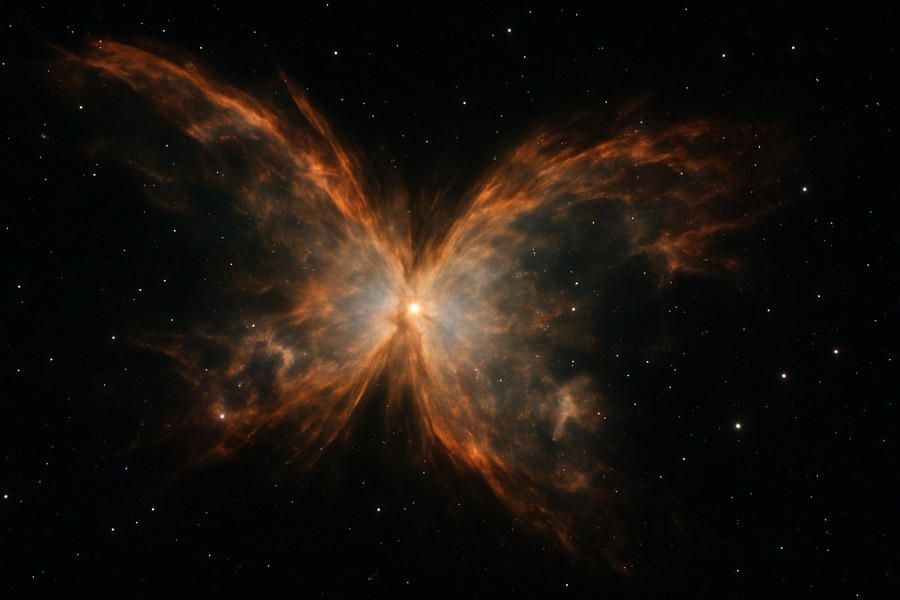
Exploring the Cosmic Butterfly
The majestic Butterfly Nebula, nestled in the Scorpius constellation, is about 3400 light-years from our planet. Recently, an advanced space telescope has shed light on its complex core, unveiling previously unseen attributes of this planetary nebula.
Understanding Planetary Nebulas
Despite their misleading name, planetary nebulas have nothing to do with planets. They got their name centuries ago when astronomers noted their round shape, which resembled planets. However, not all planetary nebulas are round; the Butterfly Nebula is a striking example of the fascinating forms these nebulas can take.
Planetary nebulas are created when stars about 0.8 to 8 times the mass of our sun lose most of their mass towards the end of their life cycle. This phase is transient, lasting only around 20,000 years.
The Anatomy of the Butterfly Nebula
The Butterfly Nebula is a bipolar nebula, meaning it has two lobes that spread out in opposite directions, making it resemble a butterfly's wings. A band of dusty gas forms the 'body' of the butterfly. This band is a doughnut-shaped structure, or torus, seen from the side. It conceals the nebula's central star, which is the ancient core of a sun-like star that energizes the nebula and makes it glow. This dusty torus might be the reason behind the nebula's insect-like shape, as it prevents gas from spreading out uniformly from the star.
Peering into the Heart of the Cosmic Butterfly
The new space telescope image offers an unparalleled view of the Butterfly Nebula's core and its dusty torus. The image, acquired using a camera and spectrograph that can capture pictures at many wavelengths simultaneously, reveals how the nebula's appearance alters with wavelength. The data used to create this image were enhanced with data from a powerful network of radio dishes.
Scientists studying these data identified around 200 spectral lines, each offering insights about the atoms and molecules in the nebula. These lines reveal complex, interconnected structures traced by different chemical species.
Unveiling the Nebula’s Central Star
The research team identified the location of the Butterfly Nebula's central star. This star heats a hitherto unseen dust cloud around it, causing the latter to shine brightly at mid-infrared wavelengths. Until now, the star's location had been a mystery because the surrounding dust rendered it invisible at optical wavelengths. With a temperature of 220,000 Kelvin, this star is among the hottest known central stars in a planetary nebula in our galaxy.
The Torus and Beyond
The star's intense heat is responsible for the nebula's stunning radiance, but its full power is likely harnessed by the dense band of dusty gas that surrounds it: the torus. The telescope's new data indicate that the torus consists of crystalline silicates, similar to quartz, and irregularly shaped dust particles. These dust particles, large by cosmic standards, suggest that they have been growing for a long time.
Outside the torus, the emission from various atoms and molecules forms a layered structure. High-energy ions are concentrated near the center, while lower-energy ions are found farther from the central star. Iron and nickel ions trace a pair of jets that shoot out from the star in opposite directions.
Discovering Carbon-based Molecules
The team also detected light emitted by carbon-based molecules, called polycyclic aromatic hydrocarbons (PAHs). These molecules form flat, ring-like structures, akin to the honeycomb shapes in beehives. On Earth, PAHs are often found in smoke from campfires, car exhaust, or burnt toast. The team suspects these molecules form when a 'bubble' of wind from the central star bursts into the surrounding gas. This could be the first-ever evidence of PAHs forming in an oxygen-rich planetary nebula, providing crucial insights into the formation of these molecules.
The findings have been published in a well-known scientific journal. These revelations have broadened our understanding of the Butterfly Nebula and the universe at large, thanks to the power of international collaboration and the most potent telescope ever launched into space.
